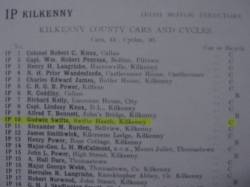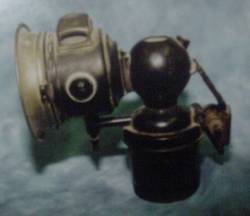
Name Plate
At one time every horse coach and cart had to have a name plate in the same
way that cars must now have a number plate.
This name plate, belonged to Lady Desart of Talbot's Inch, Kilkenny.
Source: Tony Coady.
A Day Out in Tramore
This was a big day out in Tramore for Elizabeth Butler. These were some of
the first amusements in Tramore.
Source: Elizabeth Doyle.
Motoring in 1909
This page is from the Irish Motoring Directory and Motorist's Annual (I.M.D.)
1910-1911.
It shows cars and motor cycles registered in Kilkenny in 1909. The first car
registered in Kilkenny, IP 1, was owned by Colonel Robert C. Knox of Callan.
In 1909 there were 45 cars and 30 cycles registered in the county.
The directory also included part of the Motor Act of 1903. It shows the speed limits and the fines for breaking the limits. The fine for the first offence was up to £10. The fine for the second offence was up to £50. The fine for any subsequent offence was up to £50.
There was also a list of hotels and garages in Kilkenny and gives the prices of meals and accommodation.
The directory also gave some of the troubles motorists might have had around 1909 e.g. Buzz in Coil; Clatter and Grind in Gearbox; Explosions; Knocking or Tapping in Engine; Smells; Racing of Engine; Stoppage of Engine. Each symptom had the causes listed beside it.
Carbide Bicycle Lamp
This is a Miller Carbide bicycle lamp. It was used before the battery lamp or the dynamo. The lamp has a bracket (right) to fit it onto the bicycle. The cylinder (bottom) was screwed off and filled with chunks or carbide. The reservoir (top) was filled with water. There was a tap on the top (missing) which was turned on to allow the water to drip down onto the carbide. When the water mixed with the carbide, a gas formed which flowed through a pipe into the lamp (left). In the lamp was a burner.
The front of the lamp could be opened to light the burner. This lamp has a double burner which gave better light. The carbide lamp gave good light but had a strong smell of gass. A fill of carbide would last a night. As the carbide was used, it turned into a white powder. The lamp was turned off by turning off the tap and stopping the water getting to the carbide.
John Costelloe remembers that the carbide was bought in tall tins with push-on lids. Some boys got great fun out of the empty tins. They bored a hole in the side of the tin near the bottom. They put a small piece of carbide in the tin followed by a little water. This filled the tin with gas and they then held a match to the hole . There was a loud explosion which blew the lid off the tin.
Emigration
This is a photograph of Johanna Hickey, and her son, (right), Johnny Hickey. He is heading off for Illinois, U.S.A. He died a few years ago. This photo was taken in the 1950s. In those days it was very difficult to find work in Ireland. Many other people from this area also had to emigrate like Johnny. They usually went to England, the U.S.A. or Austrailia.